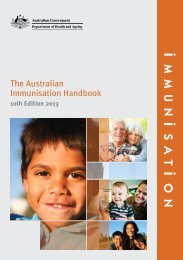3.30 MB - Academy of Medicine of Malaysia
3.30 MB - Academy of Medicine of Malaysia
3.30 MB - Academy of Medicine of Malaysia
Create successful ePaper yourself
Turn your PDF publications into a flip-book with our unique Google optimized e-Paper software.
5.3 HIV-ASSOCIATED NEPHROPATHY<br />
Strauss reported that 8% <strong>of</strong> 155 children with AIDS developed HIV-associated<br />
nephropathy (HIVAN) They presented with persistent proteinuria, azotemia,<br />
230, Level 8<br />
haematuria, renal tubular acidosis, and end-stage renal disease.<br />
Focal segmental glomerulosclerosis (FSGS) is the predominant glomerular<br />
lesion in HIVAN. Other reported glomerular lesions in patients with HIV<br />
230, Level 8 ;231, Level 8<br />
include IgA nephropathy and cryoglobulinemia.<br />
5.4 CARDIAC COMPLICATIONS<br />
HIV infected children developed cardiac complications ranging from clinically<br />
silent lesions to fatal disease. 232, Level 8 The reported complications include left<br />
ventricular dysfunction, cardiomegaly and pericardial effusion. Cardiac dysfunction<br />
233, Level 8<br />
is independent risk factor for mortality in HIV infected children.<br />
5.5 LYMPHOCYTIC INTERSTITIAL PNEUMONITIS (LIP)<br />
A study <strong>of</strong> HIV infected children with chronic lung disease showed that<br />
234, Level 8<br />
almost 60% <strong>of</strong> the patients had lymphocytic interstitial pneumonitis.<br />
Up to a third <strong>of</strong> all HIV infected children develop LIP and this usually<br />
presents in the 2nd or 3rd year <strong>of</strong> life. Affected children tend to have a better<br />
prognosis than children without LIP but secondary bacterial pneumonias<br />
and eventual bronchiectasis are common. LIP is classified as non-AIDS and<br />
Stage 3 (WHO Classification).<br />
Clinical features that are <strong>of</strong>ten associated with LIP include generalised and<br />
symmetrical lymphadenopathy, bilateral chronic non-tender parotid swelling,<br />
digital clubbing and hepatomegaly. Typical radiographic findings are diffuse<br />
bilateral reticulonodular infiltrates. ART improves symptoms and radiographic<br />
appearances <strong>of</strong> LIP and resolution <strong>of</strong> LIP has been reported among adults<br />
235, Level 9; 236, Level 9<br />
receiving HAART<br />
6. OTHER ISSUES<br />
6.1 DISCLOSURE<br />
MANAGEMENT OF HIV INFECTION IN CHILDREN<br />
Perinatally acquired HIV infection has become a chronic illness due to<br />
advances in medical treatment. As an increasing number <strong>of</strong> children infected<br />
with HIV live to older ages, the question <strong>of</strong> disclosure <strong>of</strong> the diagnosis (to the<br />
child and others) becomes more crucial. This maybe particularly challenging<br />
when children reach school going age. Their psychosocial needs are also<br />
changing to more closely resemble the needs <strong>of</strong> the chronically ill individual,<br />
rather than the terminally ill. Disclosure <strong>of</strong> the child's HIV diagnosis is<br />
controversial and an emotionally laden issue. The importance <strong>of</strong> disclosure<br />
relates directly to medication adherence, treatment compliance, child's<br />
developing autonomy and avoids potential transmission to sexual partners.<br />
48

















